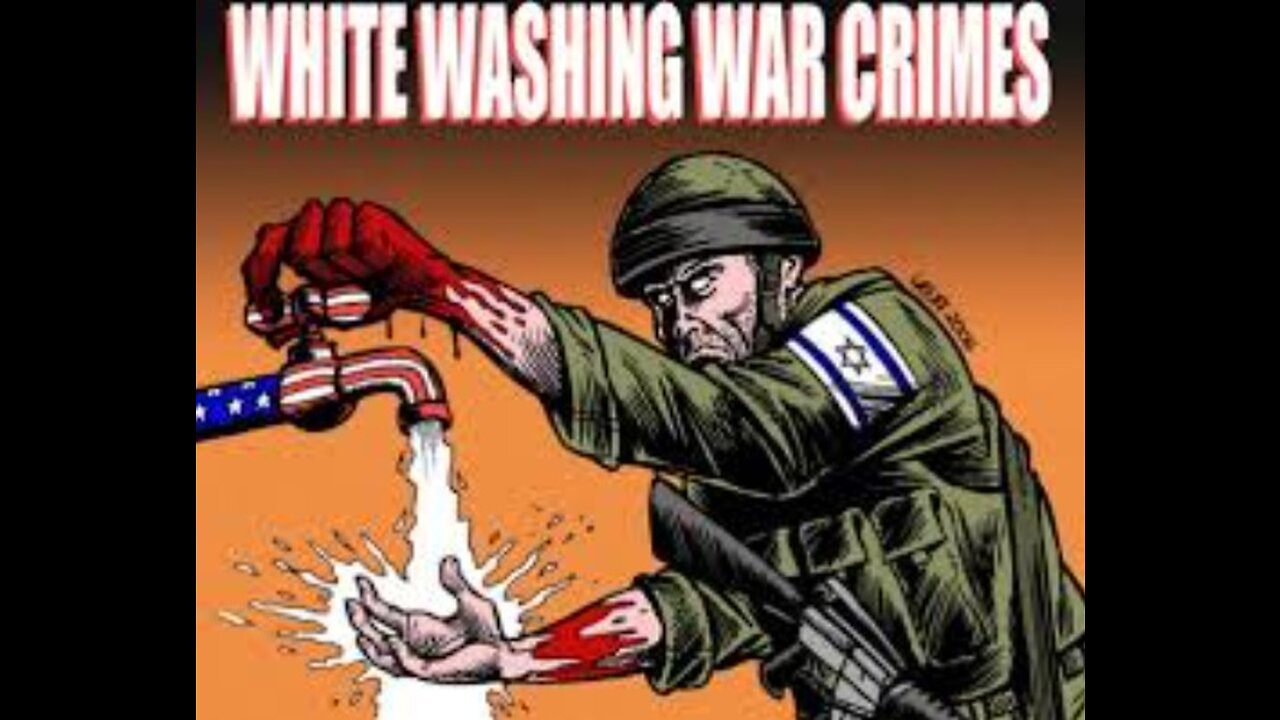Premium Only Content

Crimes Against Humanity False ? How War Criminals Not Brought To Justice Is True ?
International War Crimes Tribunals are courts of law established to try those accused of committing atrocities and crimes against humanity in wartime, such as genocide, torture, and rape. Since 1945 several tribunals have been held under United Nations or Allied authority. The Nuremberg Tribunals were held at the end of World War II to try leading figures such as Hermann Goering who was charged with four categories including crimes against humanity but committed suicide before his sentence could be carried out.
Crime, although committed against a person, is an offence against law and order of a State and that is why it constitutes a crime against a State and State prosecutors (public prosecutors) pursue a criminal case. War crimes, genocide and crimes against humanity are offences against humankind because it denigrates human dignity. That is why every country has an obligation under international law to try individuals who allegedly perpetrated such crimes, irrespective of the fact whether such crimes were committed in that State or not. Moreover, the trial of the war criminals is a demand of humanity and human civilization. If injustice and war crimes are allowed to go without fair and proper trials, there will remain question regarding the continuity, integrity and humanist elements of human civilization and its existence. The recent upsurge, however, poses more questions than answers. Bangladesh earned its long-cherished independence following a nine-month battle with West Pakistan . The mainstream discourse on this battle is very long on narratives, but short on facts. The narratives are so deeply rooted and embedded in the mainstream political and social discourse that search for facts is sometimes regarded as a crime. Many facts on the battle therefore remain as fictions. One of the conspicuous fictions is “war criminals.”
Article 147 of the Fourth Geneva Convention defines war crimes as: “Willful killing, torture or inhuman treatment, including… willfully causing great suffering or serious injury to body or health, unlawful deportation or transfer or unlawful confinement of a protected person, compelling a protected person to serve in the forces of a hostile power, or willfully depriving a protected person of the rights of fair and regular trial, …taking of hostages and extensive destruction and appropriation of property, not justified by military necessity and carried out unlawfully and wantonly. ”At the heart of the concept of war crimes is the idea that an individual can be held responsible for the actions of a country or that nation’s soldiers. Genocide, crimes against humanity, mistreatment of civilians or combatants during war can all fall under the category of war crimes. Genocide is the most severe of these crimes.
The Geneva Protocol is a protocol to the Convention for the Supervision of the International Trade in Arms and Ammunition and in Implements of War signed on the same date, and followed the Hague Conventions of 1899 and 1907. It prohibits the use of "asphyxiating, poisonous or other gases, and of all analogous liquids, materials or devices" and "bacteriological methods of warfare".
The body of laws that define a war crime are the Geneva Conventions and the statutes of the International Criminal Tribunal in The Hague (ICTY). As with Germany Nazi and Japanese experimentation, the U.S. would use the research gained via these war crimes to enhance their own biological warfare program.
Research reports and publications of various organizations working with the trial of war crimes occurred in 1971, journals, reports, booklets, newsletters, photographs, and newspaper clippings have been reviewed. Existing information have also been extracted from various aspects to enable readers to understand this national issue relating to trial of war crimes from various perspectives. Several key informants have been interviewed to add additional perspective on the trial of war crimes. Some similar trials conducted throughout the world have been given as reference.
Geneva Gas Protocol, in full Protocol for the Prohibition of the Use in War of Asphyxiating, Poisonous or Other Gases, and of Bacteriological Methods of Warfare, in international law, treaty signed in 1925 by most of the world’s countries banning the use of chemical and biological weapons in warfare. It was drafted at the 1925 Geneva Conference as part of a series of measures designed to avoid repetition of the atrocities committed by the belligerents in World War I.
Building on several treaties that had ended World War I (notably the Treaty of Versailles [1919] between the Allies and Germany), the Protocol specifically prohibited the use in war of asphyxiating, poisonous, or other gases and bacteriological weapons. The protocol did not ban the development, production, or stockpiling of such weaponry, however. For that reason, the protocol was later supplemented by the Biological Weapons Convention (BWC) of 1972 and the Chemical Weapons Convention (CWC) of 1993.
The widespread use of asphyxiating gas during World War I ushered in a new era of human-inflicted mass destruction and greatly alarmed the international community. The peace treaties that the victorious Allies signed with defeated Germany, Austria, Bulgaria, and Hungary signaled a strong recognition of the immense danger that chemical and biological weapons represented. The 1925 Geneva Conference, organized by the League of Nations, the predecessor to the United Nations, took those treaties one step further. At the initiative of the United States, France, and Poland, the participant countries at the conference drafted what came to be known as the Protocol for the Prohibition of the Use in War of Asphyxiating, Poisonous or Other Gases, and of Bacteriological Methods of Warfare.
The protocol was signed and ratified by many countries in the years before World War II. The United States, however, did not officially ratify the protocol until 1975, although it considered itself bound by the ban throughout the war and abided by the signatories’ call for the protocol to become “part of International Law, binding alike the conscience and the practice of nations.”
Since its inception in 1925, the Geneva Gas Protocol has been an important piece of international legislation, and most countries in the world have officially recognized it—including all countries that have a known capability to produce chemical and biological weapons.
The limitations of the protocol, however, became evident soon after the Geneva Conference. At the time of its signing, several major powers (including the United Kingdom, France, and the Soviet Union) explicitly reserved the right to use the forbidden weapons for retaliatory purposes. In other words, should a state decide to use chemical or bacteriological weapons against another country, in full defiance of the stipulations of the protocol, the country under attack would legally be allowed to respond in kind. Also, the 1925 document failed to address the production, storage, testing, and transfer of the forbidden weapons, a failure that allowed countries such as the Soviet Union and the United States to amass large supplies of chemical and bacteriological agents. Despite its obvious inadequacies, the protocol remains the legal foundation for a long series of multilateral treaties dealing with the threat that weapons such as mustard gas and anthrax represent.
Nuremberg Code: Directives for Human Experimentation The judgment by the war crimes tribunal at Nuremberg laid down 10 standards to which physicians must conform when carrying out experiments on human subjects in a new code that is now accepted worldwide. Read the founding documents of modern medical ethics, The Nuremberg Code, the Declarations of Helsinki and Geneva, and the International Code of Medical Ethics, which articulate a core set of ethical principles to guide human experimentation and clinical care. Nuremberg Code is a 10-point set of rules for the conduct of human experiments articulated in 1947 in the trials of Nazi doctors and bureaucrats convicted of crimes against humanity for their roles in concentration camp experiments.
These horrific war crimes reveal a humanity that isn't good or bad, but absolutely sadistic. human nature is an amorphous thing: Optimists and pessimists can look at the same human history and present diametrically opposed assessments of the human spirit.
The optimist will point to acts of selflessness and historical displays of a collective will toward waging progress in making their case that human nature is essentially “good.”
The pessimist will present ceaseless wars, slavery, and a host of other social ills peppering human history to construct a human nature that is more savage than humane.
Both are correct in their evaluations of the human condition. But it is acts of particularly relentless, unfettered violence that shock both the optimist and pessimist. These acts present not a humankind that is basically good, bad, or a little bit of both, but one that is absolutely sadistic.
Here are eight (8) of those very acts — and ones which may make Memorial Day assume a darker meaning: T4 Euthanasia Program In August 1939, healthcare providers throughout Germany received a missive from the Reich Ministry of the Interior. The note stipulated that all physicians, nurses, and midwives report newborn infants (under the age of three) who appeared to suffer from severe mental or physical disabilities.
Two months later, in October, these health experts started suggesting that parents send disabled children to certain pediatric clinics in Germany and Austria for treatment. The catch was that children sent to these clinics would not be helped; they would be killed.
This program — started by Adolf Hitler and which eventually comprised the near totality of Germany’s psychiatric community — was called the T4 program, coming from the address of the enterprise: Tiergartenstrasse 4.
T4 essentially created a “death panel”: A bureaucracy of physicians was charged with deciding who had a “life unworthy of life,” and who did not. To make such a decision, T4 planners distributed surveys to public health officials, hospitals, institutions, and elderly homes, placing particular emphasis on establishing the patient’s ability to work.
Nazi emphasis on productivity shaped much of their justification for euthanasia. Indeed, they argued that funds could “better” be used on those who were not insane or suffering from a terminal illness — and that those who did led “burdensome lives” or were “useless eaters” were fit only to die.
And that they did. Patients were shipped off to these “clinics,” where they entered “shower facilities” that were actually gas chambers. Dead bodies were disposed of in ovens. Their ashes were placed in urns and sent back to their families, along with a falsified account of their death.
The T4 program — which “officially” ended in 1941 and which the U.S. Holocaust Museum estimates killed at least 5,000 physically and mentally disabled German children — was a chilling vision of things to come. It was Germany’s first mass killing program, preceding the extermination camps that took shape some years later.
Worst War Crimes: Unit 731 Between 1937 and 1945, the Imperial Japanese Army conducted lethal human experimentation in northeast China, predominantly on Chinese and Russian populations.
The group conducting the experiments was known as Unit 731, and while it eventually comprised 3,000 researchers, it started with one man: Lieutenant-General Ishii Shiro.
Shiro hoped to use his knowledge of science to help make Japan a global power. When the government took an interest in biological weapons following the 1925 Geneva Protocol ban on germ warfare — coupled with Japan’s acquisition of Manchuria, which made for a high supply of “test subjects” — Shiro set up shop and started conducting his deadly science/war crimes.
Officially, the tests were conducted to “develop new treatments for medical problems that the Japanese Army faced,” the New York Times reported.
However, throughout the years, researchers vivisected prisoners (often without anesthesia); injected diseases such as syphilis, anthrax, and gonorrhea into victims; raped women to conduct experiments on their fetuses; used prisoners as human targets for grenades; and even burned people alive. Outside of the unit, the Japanese army dropped plague-carrying fleas onto Chinese villages to study how quickly the disease spread.
Subjects were called marutas, or logs, and according to The New York Times, they were generally Communist sympathizers or ordinary criminals. Over this time period, anywhere from 3,000 to 250,000 people died in a single camp. What is perhaps most disturbing is that these sorts of experiments were not isolated to Unit 731, and that many doctors simply considered these procedures routine.
In spite of this, many Unit 731 researchers never stood trial for war crimes. Instead, the United States, eager to beat the Soviet Union in the global arms race, granted them immunity on the condition that they give the U.S. the information they gathered when conducting their experiments. Two declassified government documents reveal that the U.S. eventually paid over $2.3 million (in today’s dollars) for that data. As with Germany Nazi and Japanese experimentation, the U.S. would use the research gained via these war crimes to enhance their own biological warfare program.
Toward the end of the 20th century, the nation descended into decades-long civil war, the harrowing history of which has been shaped by child soldiers, cannibalism, and especially mass rape. The use of rape was so widespread and routine that the U.N. decided to consider rape to be an instrument, not a side effect, of war. Whether it’s meant to instill fear in local populations or encourage the abandonment of property and the collapse of domestic relations, rape as a military strategy in the past wars does not discriminate.
Women of all ages have been targets of these rapes; victims have been as young as 18 months old or as old as 80. In some instances, women’s genitalia are mutilated, with their families being forced to watch.
Paraquat Pot: The True Story Of How The US Government Tried To Kill Weed Smokers With A Toxic Chemical In The 1980s When people talk about “killer weed,” that’s typically understood to mean really good weed. But due to US government policies that started in the 1970s and extended through most of the 1980s, marijuana fields were being sprayed with a chemical that can actually kill you.
The chemical, known as “paraquat,” is an herbicide sprayed over marijuana fields in Mexico in the 1970s—with the aid of US money and US-provided helicopters—and over marijuana fields in Georgia in the 1980s under the direction of the Reagan Administration.
But normally, anything poisonous enough to kill plants is also toxic enough to kill humans, and that is the case with paraquat.
Paraquat is an organic acid that is used as an herbicide. It kills green plant tissue on contact.
• When sprayed on plants, paraquat is tasteless and odorless and invisible. In other words, you wouldn’t be able to tell if the weed you were smoking had been sprayed with paraquat.
• As far as breathable poisons go, the government has placed paraquat in Toxicity Category I—the highest possible level.
• Due to the fact that it is cheap and available, liquid paraquat is frequently used in suicides throughout much of the Third World.
• In humans, exposure to paraquat has been linked to the development of Parkin’s disease.
• Depending on the dose and the method of ingestion, paraquat can either be immediately fatal or can lead to kidney, liver, lung, and heart failure for up to 30 days after exposure.
• Tests performed in 1977 demonstrated that combusted paraquat caused damage to the lungs of laboratory rats.
• In 1978, after years of attempting to reassure Americans that smoking paraquat-tainted marijuana was safe, US Secretary of Health Education and Welfare Joseph Califano announced that new tests found that heavy smokers of tainted weed could develop irreversible lung damage and that even moderate users could develop “clinically measurable damage.”
1920 Poisoned Alcohol In 1926, the federal government poisoned alcohol to curb consumption during Prohibition; by the time Prohibition ended in 1933, an estimated 10,000 people had died from this poisoning. ... When the manufacture and sale of alcohol was illegal between 1920 and 1933, regulatory agencies encouraged.
As if Americans hadn't accumulated enough dark suspicions about their government over the past 50-odd years, along comes an Internet factoid holding that the United States government intentionally (and fatally) poisoned more than 10,000 of its own citizens between 1926 and 1933:
To sell the stolen industrial alcohol, the liquor syndicates employed chemists to "renature" the products, returning them to a drinkable state. The bootleggers paid their chemists a lot more than the government did, and they excelled at their job. Stolen and redistilled alcohol became the primary source of liquor in the country. So federal officials ordered manufacturers to make their products far more deadly.
By mid-1927, the new denaturing formulas included some notable poisons—kerosene and brucine (a plant alkaloid closely related to strychnine), gasoline, benzene, cadmium, iodine, zinc, mercury salts, nicotine, ether, formaldehyde, chloroform, camphor, carbolic acid, quinine, and acetone. The Treasury Department also demanded more methyl alcohol be added—up to 10 percent of total product. It was the last that proved most deadly.
It wasn't just the violent Prohibition-era gang wars that were dangerous to Americans drinking homemade moonshine and bathtub gin. According to the Dec. 26, 1922 edition of the New York Times, five people were killed in the city on Christmas Day from drinking "poisoned rum." That was only the beginning. By 1926, according to Prohibition, by Edward Behr, 750 New Yorkers perished from such poisoning and hundreds of thousands more suffered irreversible injuries including blindness and paralysis. On New Year's Day 1927, 41 people died at New York's Bellevue Hospital from alcohol-related poisonings. Oftentimes, they were drinking industrial methanol, otherwise known as wood alcohol, which was a legal but extremely dangerous poison. One government report said that of 480,000 gallons of liquor confiscated in New York in 1927, nearly all contained poisons.
U.S. Government said and or told Us - We The People - Agent Orange - Yes It's Safe - The Chemical That Destroyed Generations. The U.S. defeated most of the resolutions, arguing that Agent Orange was not a chemical or a biological weapon as it was considered a herbicide and a defoliant and it was used in effort to destroy plant crops and to deprive the enemy of concealment and not meant to target human beings.
Agent Orange, mixture of herbicides that U.S. military forces sprayed in Vietnam from 1962 to 1971 during the Vietnam War for the dual purpose of defoliating forest areas that might conceal Viet Cong and North Vietnamese forces and destroying crops that might feed the enemy.
Agent Orange was a mixture of plant-killing chemicals (herbicides) used by the United States military during the Vietnam War as a defoliant to remove tree cover, destroy crops, and clear vegetation around US bases. About 3 million Americans served in the armed forces in Vietnam and nearby areas. Many of these veterans, as well as other people in the area, were exposed to Agent Orange.
Exposure to Agent Orange could have occurred when the chemicals were breathed in, ingested in contaminated food or drinks, or absorbed through the skin. Exposure might have been possible through the eyes or through breaks in the skin, as well.
One of the challenges in assessing the health effects of Agent Orange exposure has been determining how much an individual was exposed to (or even what they were exposed to). Very little information on this is available.
The Vietnam Memorial lists the names of more than 58,000 Americans who died. However, the wall does not document the names of the 2.8 million U.S. veterans exposed to the deadly chemical Agent Orange, and later died. Let's honor those who made the ultimate sacrifice during war - and because of war.
Notice to Researchers in Records Released under the Nazi War Crimes Disclosure Act and the Japanese Imperial Government Records Act
The Nazi War Crimes and Japanese Imperial Government Records Interagency Working Group (IWG), in implementing the Nazi War Crimes Disclosure Act and the Japanese Imperial Government Records Act, has taken the broadest view in identifying records that may be responsive to the Acts. Information relevant to the Acts is often found among files related to other subjects. In order to preserve the archival integrity of the files, the IWG and the National Archives and Records Administration, where possible, have released entire files together, not just those items related to Nazi or Japanese war criminals, crimes, persecution, and looted assets. These records may relate to persons who are war criminals, former Axis personnel who are not war criminals, victims of war crimes or persecution, or civilian or military personnel investigating Nazi activities; the records may also include mention of, or information about, persons having no connection to these activities.
The political differences between the Soviet Union on the one hand and the United States and Great Britain on the other were too severe to be reconciled. Sooner or later, there would be a falling out with enormous consequences. That falling out would be called the Cold War. In its early days, before it got its name, when Germany was collapsing in defeat, an opportunity unlike any other occurred. It was also an opportunity not without moral cost, a “deal with the devil.” But with national security at issue, a special operations mission was authorized. It was called “Paperclip.”
Operation Paperclip, named after the use of the ordinary paperclip attached to the personnel files of select German scientists, was a special operation of breathtaking scope. Instead of highly trained teams tasked for important combat missions, these teams were hunters and gatherers sifting and searching through the wreckage and ruin of a devastated Germany. Theirs was a high-stakes contest against an equally determined Russia and other less malevolent former allies. German scientists and technologies were the pawns, and the prize was nothing less than national security and preeminence as a world power. When it was concluded, hundreds of German scientists and war crimes and their families over 3,000 people, tons of documents, hardware, weapon systems, and technologies would be transferred from Germany to the United States.
The occupying US government undertook the cover-up of Japanese war crimes after the end of World War II, granting political immunity to military personnel who had engaged in human experimentation and other crimes against humanity, predominantly in mainland China. The pardon of Japanese war criminals, among whom were Unit 731's commanding officers General Shiro Ishii and General Masaji Kitano, was overseen by General of the Army Douglas MacArthur in September 1945. While a series of war tribunals and trials was organized, many of the high-ranking officials and doctors who devised and respectively performed the experiments were pardoned and never brought to justice due to the US government both classifying incriminating evidence, as well as blocking the prosecution access to key witnesses. As many as 12,000 people, most of them Chinese, died in Unit 731 alone and many more died in other facilities, such as Unit 100 and in field experiments throughout Manchuria and also when it was concluded, hundreds of Japanese war crimes and scientists and their families over 1,378 people, tons of documents, hardware, weapon systems, and technologies would be transferred from Japanese to the United States.
During the cover-up operation, the U.S. government paid money to obtain data on human experiments conducted in China, according to two declassified U.S. government documents.
The total amount paid to unnamed former members of the infamous unit was somewhere between 150,000 yen to 200,000 yen. An amount of 200,000 yen at that time is the equivalent of 20 million yen to 40 million yen today.
Hirohito, as emperor, gave his consent regarding the policies and activities of Unit 731, Unit 100 and lots of other human experimentation facilities. Despite this, there is no evidence that he was thoroughly informed on most of the atrocities that occurred within the facilities. He was one of many that would be granted immunity. Though it is unclear on whether Emperor Hirohito was made aware of the full extent of Unit 731, the emperor's younger brother, Prince Mikasa, had toured the headquarters of Unit 731 and wrote in his memoirs that he watched films of how Chinese prisoners were "made to march on the plains of Manchuria for poison gas experiments on humans.
-
 1:13:00
1:13:00
What If Everything You Were Taught Was A Lie?
5 days agoWhy Staying Single Is The Best Thing You Can Do In Life Or The Lie That You Need A Soul Mate?
1.78K1 -
 7:33
7:33
Talk Nerdy Sports - The Ultimate Sports Betting Podcast
4 hours agoFriday Night Lights in BRAZIL 🇧🇷🔥🏈
19 -
 LIVE
LIVE
Reidboyy
1 hour ago$20 Billion Dollar Warzone Tournament! Protect The President
100 watching -
 1:15:26
1:15:26
Tucker Carlson
2 hours agoWhistleblower Exposes the Real Puppet Masters Controlling the State Department and Plans for Gaza
38.7K32 -
 LIVE
LIVE
StoneMountain64
2 hours agoHelldivers 2 just KEEPS GETTING BETTER
60 watching -
 2:10:10
2:10:10
The Culture War with Tim Pool
4 hours agoNational Guard Sent To Chicago - Fascism Or Salvation Debate | The Culture War with Tim Pool
146K169 -
 2:16:36
2:16:36
Side Scrollers Podcast
3 hours agoStreamer KICKED OUT of Renaissance Fair for Misgendering + Spiderman MELTDOWN | Side Scrollers Live
17.9K -
 LIVE
LIVE
Viss
2 hours ago🔴LIVE - Learn How To Dominate The Solo Battleground - PUBG
88 watching -
 1:35:52
1:35:52
Sean Unpaved
3 hours agoFumbles, Flubs, & Loogies: NFL Opener Chaos
14.2K -
 1:45:03
1:45:03
The Shannon Joy Show
2 hours ago🔥🔥Friday Freestyle! - MAGA Erupts Over Trump-Gates Bromance🔥🔥
8.21K7